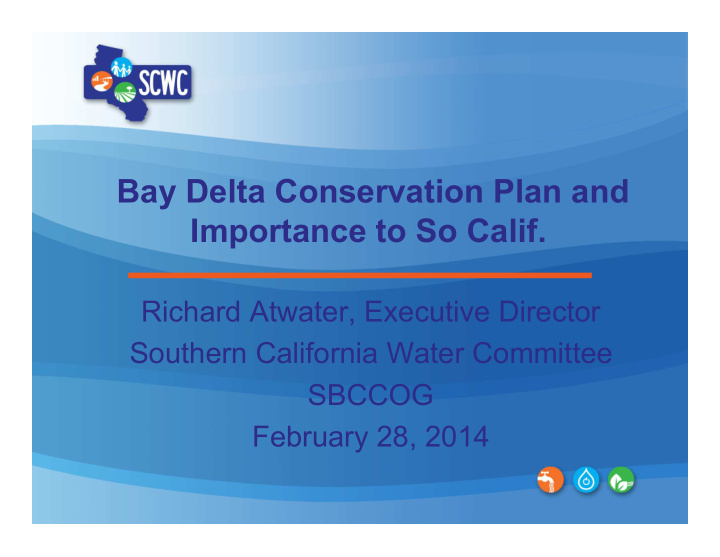



Bay Delta Conservation Plan and Importance to So Calif. Richard Atwater, Executive Director Southern California Water Committee SBCCOG February 28, 2014
Sources ¡of ¡Water ¡for ¡Southern ¡California ¡ Sierra ¡Mtns ¡ LA ¡Aqueduct ¡ Delta ¡ Colorado ¡River ¡ Aqueduct ¡ State ¡Water ¡ Project ¡ ¡ Conserva?on ¡ Local ¡Groundwater ¡ & ¡Recycling ¡
Sacramento-San Joaquin Delta: California’s Water Epicenter
A Vulnerable & Incomplete System § Past generations invested in a network of dams, aqueducts and pumps to move water around the state § 100-year-old man-made levee system is old and fragile § Much of the land has subsided below sea level § Future sea level rise and changing weather patterns will put greater pressure on the levees
How likely is a major earthquake (6.7 magnitude) to hit Northern California?
Water Movement in California The Delta — Central Valley Project — State Water Project — Local Projects
A retrofit of the existing system that secures it from risk of flood, earthquake and sea level rise in the Delta is the most sensible approach
Investing In The Seismic Retrofit § Project is prudent, affordable & urgently needed § Cost of the water conveyance project would be covered by public water agencies § ~$14 billion § Project would be financed over many years § No state general fund dollars involved § Broader funding sources, including potentially voter approved bonds, would pay for environmental improvements
An Investment Long Overdue $$$ ¢ Bridges & Highways Hospitals Public California’s Water Schools Delivery System Prisons
Regional Water Investments • Water Conservation and Efficiency • Recycled Water • Groundwater clean up efforts • Groundwater storage for droughts • Stormwater capture
Heavy ¡dependence ¡on ¡ ¡ Emphasis ¡on ¡conserva5on, ¡local ¡ imported ¡supplies ¡ supplies, ¡storage ¡& ¡transfers ¡
220 ¡ ¡ 210 ¡ ¡ 200 ¡ ¡ Gallons ¡per ¡Capita ¡per ¡Day ¡(GPCD) ¡ Regional GPCD 190 ¡ ¡ 1996-2005 Average = 177 GPCD 180 ¡ ¡ 170 ¡ ¡ 160 ¡ ¡ 150 ¡ ¡ 2020 goal = 141 GPCD 140 ¡ ¡ 130 ¡ ¡ 120 ¡ ¡ 1996 ¡ 1998 ¡ 2000 ¡ 2002 ¡ 2004 ¡ 2006 ¡ 2008 ¡ 2010 ¡ 2012 ¡ 2014 ¡ 2016 ¡ 2018 ¡ 2020 ¡
2010 Service Area Water Supplies Total Retail Demand: 3.6 MAF
Primary Secondary Tertiary Pretreatment & Source Control Industrial 95% TOC Removal Influent TOC to 7.0 mg/L Avg. Avg. 165 mg/L Distribution System Industrial & Brine Export Groundwater Blend & Hold Soil-Aquifer Treatment 50% TOC Removal 75% TOC Removal to ±2 mg/L to ±1 mg/L
Using ¡Water ¡Over ¡And ¡Over ¡Again: ¡ Recycling ¡
HHH Inves?ng ¡in ¡Efficiency ¡
Invested ¡$10 ¡billion ¡since ¡ 1995 ¡ ¡ ¡ Number of Program Annual (AF) Projects 100+ 450,000 Recycling Groundwater 9 350,000 Storage GW & 240,000 Desalination Seawater
~ 3 MAF of Available Storage Space 2011 Northwest MWD Service Area Basins NA San Fernando Valley Basins 510,000 LA County Coastal Plain Basins 484,300 San Gabriel Valley Basins 353,000 Orange County Basins 218,000 500,000 Inland Empire Basins 0 Eastside MWD Service Area Basins 600,000 San Diego County Basins NA
Multi-Use Project Types Site Specific LID -- Water Supply and Water Quality Erosion and Sedimentation Traditional Water Supply Flood Protection and Drainage Water Quality Streetscape Habitat and Environment Recreation Trails and Education
Deep Percolation of Stormwater Source: SCWC Stormwater White Paper
Stormwater: A Smart & Sensible Solution • 450,000 acre-feet of stormwater is currently captured and recharged into So Cal groundwater basins per year (enough water for 3 million people/year) • Billions of gallons are lost every year because we don’t have enough stormwater capture systems • Capturing stormwater is viable, cost-effective and environmentally preferable • Capturing stormwater provides numerous benefits, including: • Creating more local water supplies • Reducing polluted run-off • Providing a cost-effective water supply option
Stormwater Capture Types • Individual • Neighborhood • Large Scale
Small Scale Projects Whitnall Highway Power Line Easement Project • LADWP Project. • Conceptual plan being developed. • Project expected to increase groundwater recharge by more than 110 acre-feet per year. • Goal is to capture and infiltrate stormwater beneath LADWP power lines using swales and ponds. • Designs expected in 2013. Courtesy of Los Angeles Department of Water and Power
Large Scale Projects Pacoima Spreading Grounds Project • LACFCD/LADWP Project. • Estimated cost $32 million. • Increased recharge by 2,000 acre-feet annually. • Designs expected in late 2012. Lopez Spreading Grounds Project • LACFCD/LADWP Project. • Increased recharge by 750 acre-feet annually. • Designs expected in 2013. • Estimated cost $8 million. Courtesy of Los Angeles Department of Water and Power
27 ¡
Thank You! Richard Atwater Southern California Water Committee
Recommend
More recommend